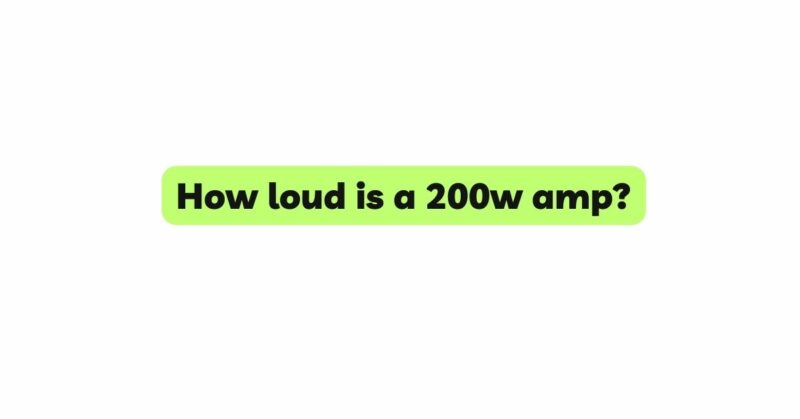Amplifiers are the heart of any audio system, responsible for driving speakers and bringing music to life. When considering amplifier power, the question of loudness inevitably arises. In this article, we aim to explore and quantify how loud a 200-watt amplifier can be. We will delve into the relationship between amplifier power and perceived loudness, the concept of sound pressure levels (SPL), and the real-world implications of a 200-watt amplifier’s volume capabilities.
- Understanding Amplifier Power and Wattage:
Before we delve into the loudness of a 200-watt amplifier, it is crucial to comprehend the concept of amplifier power and wattage. Amplifiers are electronic devices that take an audio signal and amplify it to a level suitable for driving speakers. The power rating of an amplifier is typically expressed in watts (W) and indicates the amount of electrical power it can deliver to the speakers.
Higher wattage amplifiers can, in theory, produce louder sound output than lower wattage ones due to their ability to supply more power to the speakers. However, perceived loudness depends on various factors beyond wattage alone.
- The Relationship Between Amplifier Power and SPL:
To measure loudness, sound engineers and audiophiles use the decibel scale (dB). The decibel scale is a logarithmic unit that quantifies sound pressure levels (SPL) concerning the threshold of human hearing. The threshold of human hearing is set at 0 dB, and sounds above this level are perceived as louder.
One important thing to understand is that the decibel scale is not linear; it is logarithmic. A 3 dB increase in SPL corresponds to approximately doubling the sound intensity, while a 10 dB increase is perceived as doubling the loudness by the human ear.
- The Loudness of a 200-Watt Amplifier:
Now, let’s examine how loud a 200-watt amplifier can be. Assuming that the 200-watt amplifier is well-matched with speakers of appropriate power handling capabilities, it can deliver higher sound pressure levels than a lower wattage amplifier. Compared to a 100-watt amplifier, a 200-watt amplifier would provide a 3 dB increase in SPL, which, as mentioned earlier, is a noticeable but not dramatic change in perceived loudness.
In practical terms, this means that a 200-watt amplifier might be marginally louder than a 100-watt amplifier. However, it will not be perceived as twice as loud due to the logarithmic nature of the decibel scale.
- Factors Influencing Perceived Loudness:
While amplifier power plays a role in loudness, it is essential to consider other factors that significantly impact perceived loudness:
a. Speaker Efficiency: Speaker efficiency, measured in dB per watt per meter (dB/W/m), indicates how efficiently a speaker converts electrical power into acoustic energy. Higher efficiency speakers require less amplifier power to achieve a certain SPL, making them sound louder with the same wattage amplifier compared to less efficient speakers.
b. Room Acoustics: The listening environment greatly influences perceived loudness. Room size, shape, and furnishings can affect sound reflections, absorption, and diffusion, altering the way we hear sound.
c. Listening Distance: The distance between the listener and the speakers can affect how loud the sound appears. As the listener moves farther away, the perceived loudness decreases.
d. Music Content and Dynamic Range: The type of music being played and its dynamic range can influence perceived loudness. Music with higher dynamic range may require more amplifier power to maintain consistent loudness levels.
- Potential Challenges with High-Powered Amplifiers:
While a 200-watt amplifier can deliver louder sound, it is essential to use caution to avoid potential drawbacks. Using an amplifier with higher power than the speakers can handle may lead to speaker damage due to overpowering, even if it doesn’t result in significantly louder perceived volume. Moreover, pushing an amplifier to its limits can cause clipping and distortion, which negatively impacts sound quality. Matching the amplifier’s power output to the speaker’s power handling capabilities is crucial for optimal performance and protection of both components.
- Finding the Optimal Loudness:
Instead of fixating solely on the amplifier’s wattage, finding the optimal loudness requires a balanced approach. Considering the efficiency of speakers, room acoustics, listening distance, and overall system compatibility are vital for achieving the desired listening experience.
Conclusion:
In conclusion, a 200-watt amplifier can indeed produce slightly higher sound pressure levels than a 100-watt amplifier, resulting in a modest increase in perceived loudness. However, due to the logarithmic nature of the decibel scale, the difference in perceived loudness is not linearly proportional to the wattage increase.
Other factors, such as speaker efficiency, room acoustics, and listening distance, play significant roles in shaping the perceived loudness of an audio system. Rather than focusing solely on amplifier power, achieving optimal loudness involves a comprehensive approach that considers the entire audio setup, including speaker compatibility and the listening environment.
Remember that loudness is just one aspect of the audio experience, and a well-matched audio system that delivers clear, distortion-free sound is essential for a truly immersive and enjoyable listening journey.


